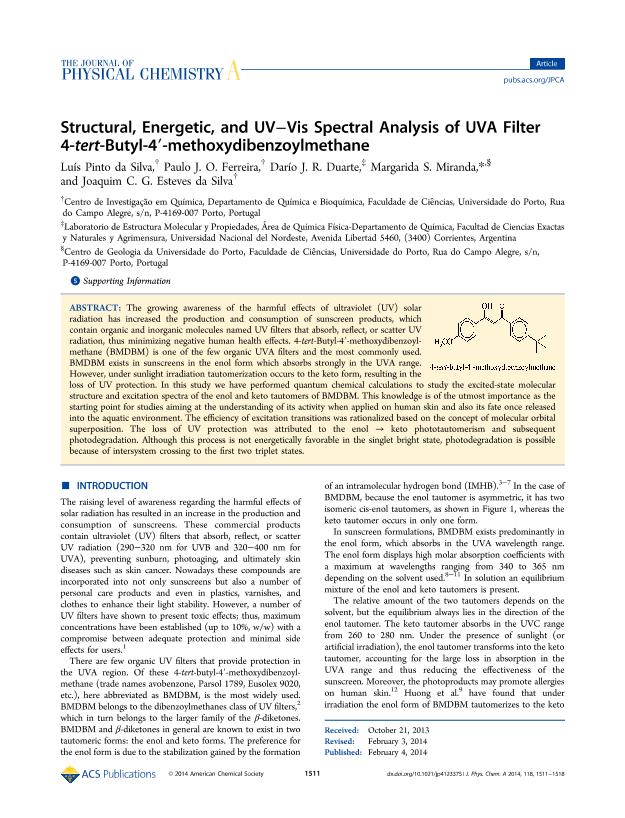Mostrar el registro sencillo del ítem
dc.contributor.author
Pinto da Silva, Luis
dc.contributor.author
Ferreyra, Paulo J. O.
dc.contributor.author
Duarte, Darío Jorge Roberto

dc.contributor.author
Miranda, Margarida S.
dc.contributor.author
Esteves da Silva, Joaquim C. G.
dc.date.available
2016-12-26T20:14:24Z
dc.date.issued
2014-02
dc.identifier.citation
Pinto da Silva, Luis ; Ferreyra, Paulo J. O.; Duarte, Darío Jorge Roberto; Miranda, Margarida S.; Esteves da Silva, Joaquim C. G.; Structural, Energetic, and UV−Vis Spectral Analysis of UVA Filter 4‑tert-Butyl-4′-methoxydibenzoylmethane; American Chemical Society; Journal Of Physical Chemistry A; 118; 8; 2-2014; 1511-1518
dc.identifier.issn
1089-5639
dc.identifier.uri
http://hdl.handle.net/11336/10224
dc.description.abstract
The growing awareness of the harmful effects of ultraviolet (UV) solar radiation has increased the production and consumption of sunscreen products, which contain organic and inorganic molecules named UV filters that absorb, reflect, or scatter UV radiation, thus minimizing negative human health effects. 4-tert-Butyl-4′-methoxydibenzoylmethane (BMDBM) is one of the few organic UVA filters and the most commonly used. BMDBM exists in sunscreens in the enol form which absorbs strongly in the UVA range. However, under sunlight irradiation tautomerization occurs to the keto form, resulting in the loss of UV protection. In this study we have performed quantum chemical calculations to study the excited-state molecular structure and excitation spectra of the enol and keto tautomers of BMDBM. This knowledge is of the utmost importance as the starting point for studies aiming at the understanding of its activity when applied on human skin and also its fate once released into the aquatic environment. The efficiency of excitation transitions was rationalized based on the concept of molecular orbital superposition. The loss of UV protection was attributed to the enol → keto phototautomerism and subsequent photodegradation. Although this process is not energetically favorable in the singlet bright state, photodegradation is possible because of intersystem crossing to the first two triplet states.
dc.format
application/pdf
dc.language.iso
eng
dc.publisher
American Chemical Society

dc.rights
info:eu-repo/semantics/openAccess
dc.rights.uri
https://creativecommons.org/licenses/by-nc-sa/2.5/ar/
dc.subject
4-Tert-Butyl-4`-Methoxydibenzoylmethane
dc.subject
Phototautomerism
dc.subject
Excited States
dc.subject
Uva Filters
dc.subject.classification
Química Orgánica

dc.subject.classification
Ciencias Químicas

dc.subject.classification
CIENCIAS NATURALES Y EXACTAS

dc.title
Structural, Energetic, and UV−Vis Spectral Analysis of UVA Filter 4‑tert-Butyl-4′-methoxydibenzoylmethane
dc.type
info:eu-repo/semantics/article
dc.type
info:ar-repo/semantics/artículo
dc.type
info:eu-repo/semantics/publishedVersion
dc.date.updated
2016-12-26T18:45:45Z
dc.journal.volume
118
dc.journal.number
8
dc.journal.pagination
1511-1518
dc.journal.pais
Estados Unidos

dc.journal.ciudad
Washington
dc.description.fil
Fil: Pinto da Silva, Luis . Universidade do Porto; Portugal
dc.description.fil
Fil: Ferreyra, Paulo J. O.. Universidade do Porto; Portugal
dc.description.fil
Fil: Duarte, Darío Jorge Roberto. Universidad Nacional del Nordeste. Facultad de Ciencias Exactas Naturales y Agrimensura; Argentina. Consejo Nacional de Investigaciones Científicas y Técnicas; Argentina
dc.description.fil
Fil: Miranda, Margarida S.. Universidade do Porto; Portugal
dc.description.fil
Fil: Esteves da Silva, Joaquim C. G.. Universidade do Porto; Portugal
dc.journal.title
Journal Of Physical Chemistry A

dc.relation.alternativeid
info:eu-repo/semantics/altIdentifier/url/http://pubs.acs.org/doi/abs/10.1021/jp4123375
dc.relation.alternativeid
info:eu-repo/semantics/altIdentifier/doi/http://dx.doi.org/10.1021/jp4123375
Archivos asociados
